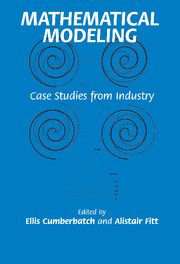Book contents
- Frontmatter
- Contents
- Contributors
- Preface
- Introduction
- 0 Mathematical Preliminaries
- 1 Fluid-Mechanical Modelling of the Scroll Compressor
- 2 Determining the Viscosity of a Carbon Paste Used in Smelting
- 3 The Vibrating Element Densitometer
- 4 Acoustic Emission from Damaged FRP-Hoop-Wrapped Cylinders
- 5 Modelling the Cooking of a Single Cereal Grain
- 6 Epidemic Waves in Animal Populations: A Case Study
- 7 Dynamics of Automotive Catalytic Converters
- 8 Analysis of an Endothermic Reaction in a Packed Column
- 9 Simulation of the Temperature Behaviour of Hot Glass during Cooling
- 10 Water Equilibration in Vapor-Diffusion Crystal Growth
- 11 Modelling of Quasi-Static and Dynamic Load Responses of Filled Viscoelastic Materials
- 12 A Gasdynamic–Acoustic Model of a Bird Scare Gun
- 13 Paper Tension Variations in a Printing Press
- Index
1 - Fluid-Mechanical Modelling of the Scroll Compressor
Published online by Cambridge University Press: 05 June 2012
- Frontmatter
- Contents
- Contributors
- Preface
- Introduction
- 0 Mathematical Preliminaries
- 1 Fluid-Mechanical Modelling of the Scroll Compressor
- 2 Determining the Viscosity of a Carbon Paste Used in Smelting
- 3 The Vibrating Element Densitometer
- 4 Acoustic Emission from Damaged FRP-Hoop-Wrapped Cylinders
- 5 Modelling the Cooking of a Single Cereal Grain
- 6 Epidemic Waves in Animal Populations: A Case Study
- 7 Dynamics of Automotive Catalytic Converters
- 8 Analysis of an Endothermic Reaction in a Packed Column
- 9 Simulation of the Temperature Behaviour of Hot Glass during Cooling
- 10 Water Equilibration in Vapor-Diffusion Crystal Growth
- 11 Modelling of Quasi-Static and Dynamic Load Responses of Filled Viscoelastic Materials
- 12 A Gasdynamic–Acoustic Model of a Bird Scare Gun
- 13 Paper Tension Variations in a Printing Press
- Index
Summary
Preface
This case study concerns the flow of gas in a so-called scroll compressor. In this device a number of chambers of gas at different temperatures and pressures are separated by narrow channels through which leakage can occur. Using compressible lubrication theory, an estimate for the leakage rate is found in terms of the material properties of the gas and the geometry of the compressor. Thus a simple functional is obtained which allows the efficiency of different compressor designs to be compared. Next we derive a set of ordinary differential equations for the temperature and pressure in each chamber; the coupling between them arises from the leakage. The numerical solution of these equations allows a realistic simulation of a working compressor, and suggests some interesting possibilities for future designs.
This problem arose at the 32nd European Study Group with Industry held in September 1998 at the Technical University of Denmark – the first to be held outside the United Kingdom. It was presented by Stig Helmer Jørgensen from DANFOSS, which is Denmark's largest industrial group and specialises in controls for refrigeration and heating. The Danish Study Group was a great success and is expected to be repeated annually henceforth. The feedback from DANFOSS has also been encouraging, and hopefully this represents the start of a long-term collaboration.
Introduction
The scroll compressor is an ingenious machine used for compressing air or refrigerant, which was invented in 1905 by Creux [1]. Unfortunately, technology was insufficiently advanced at the time for workable models to be manufactured, and it was not until the 1970s that commercial interest in the idea was revived – see e.g. [3].
- Type
- Chapter
- Information
- Mathematical ModelingCase Studies from Industry, pp. 22 - 45Publisher: Cambridge University PressPrint publication year: 2001

